|

| |
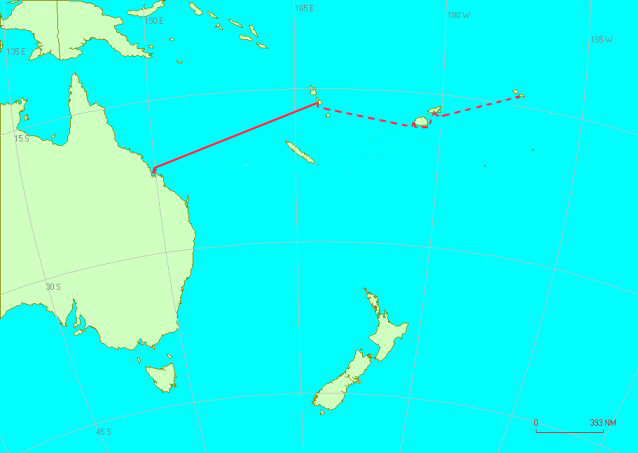
(Our course to Mackay, Queensland)
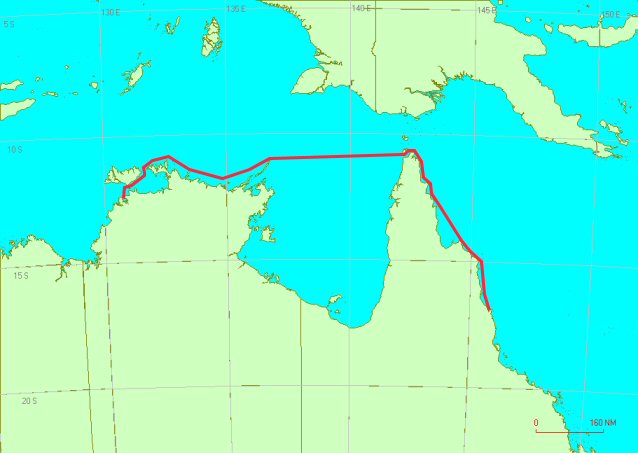
(Course from Mackay to Cape York through the
Coral Sea, then across the Arafura Sea to Darwin)
03/08/2008
CROCODILES AND KANGAROOS...
"What are we going to do during our stay in Australia?"
"We may visit the interior, to see the Kangaroos".
"Eeeeck, are you crazy? There are CROCODILES in the rivers, and deadly SNAKES
hiding in the bushes, waiting for the unsuspecting passer-by, and PYTHONS, and DINGOs...."
"We will sail along the islands of the Great Barrier reef then, diving on the
coral banks".
"Eeeeck, are you crazy? There are SHARKS there, not those puny 3-meter-long
things of Polinesia, but real, BIG man-eaters! And then there are the
BOX-JELLYFISH, almost invisible and DEADLY, and the SCORPION-FISH!! Do you
really want to die young???".
"Ok then, we will sail along the coast and anchor in the river mouths".
"Eeeeck, are you crazy? There are the SEA CROCODILES, 7-meter long beasts and
very AGGRESSIVE as well, they even EAT their freshwater cousins! And then there
is the risk that SNAKES may climb aboard, and then you need to call the Rangers
to get rid of them, because they are a protected species (the snakes, not the
tourists...)".
"Ok then, we will sail straight to Darwin without stopping".
"Eeeeck, are you crazy? Sailing at night among the reefs and rocks of the Great
Barrier??? Even Captain Cook hit the shore here!....".
"Well, yes, but Cook did not have charts, he was actually MAKING them for the
first time!".
"No no no no no, you know what? We go to Darwin sailing OUTSIDE the Barrier, and
then fly to Sidney, where the worst thing that could happen is to be run-down by
a car!..."
05/08/2008
BOOBIES...
Also in Australia they have their share of Boobies, although not as
brightly-coloured like the ones so common in Galapagos; these birds fly far out
at sea and are great fishers, but they have a somewhat dumb look that inspires
sympathy.
Yesterday evening, a booby tried for some time to land on Shaula, first aiming
at the crosstrees and later at the inviting landing strip of the large solar
panel above the stern, which in reality is dangerous due to the rotating blades
of the wind generator and to the presence of two radio aerials.
After several attempts, he seemed to have given up; in the meantime darkness had
come, and we started having dinner in the cockpit, as we often do when
conditions allow.
Suddenly, SBOIIIIING, the aerials on the stern vibrated violently, and a
feather-ball fell behind, towards the sea: the boobie had tried again to land,
and in the dark he did not see the aerials and hit them with its wingtip, losing
balance!
We could not see what happened to him, but I do not think he was seriously hurt:
he probably rested for a while, sitting in the water and wondering what had
happened...
06/08/2008
THE BOOBY HAS LANDED!!...
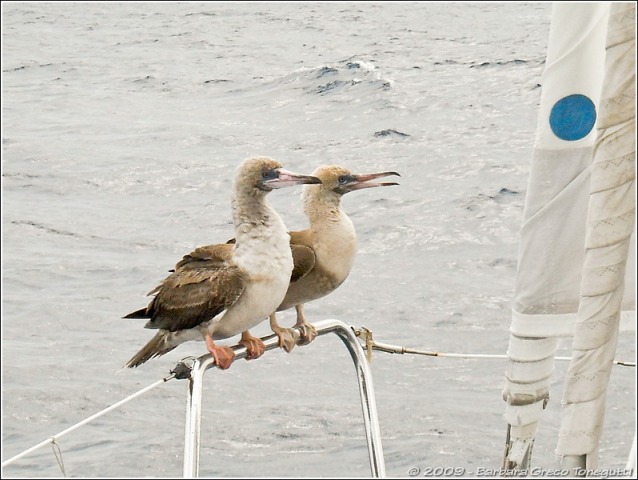
two Boobies hitch a ride on our pulpit
TWO Boobies, to be precise: this time they smartened up and landed on the
forward pulpit, one on each side. They spent the night there, sleeping
precariously and taking no care of our maneuvres.
Alas, when they left at first-light this morning, the left the bows, shall we
say,....dirty!!
Better than what happened yesterday to "Baccus", whose rudder has been
repeatedly bitten by a shark!...
The wind is very light, we are forced to use the engine to ensure arrival in
Australia before the week-end, when Customs and Immigration do not work.
09/08/2008
QUARANTINE...
We have reached Mackay, Australia.
Here they still take quarantine very seriously, like in the old days of sailing
ships! Upon arrival, one has to moor at a dedicated berth, from where you cannot
go ashore until after the quarantine people has checked all food stores and
other things like craftwork purchased around the islands, to make sure we are
not carrying any insects or diseases.
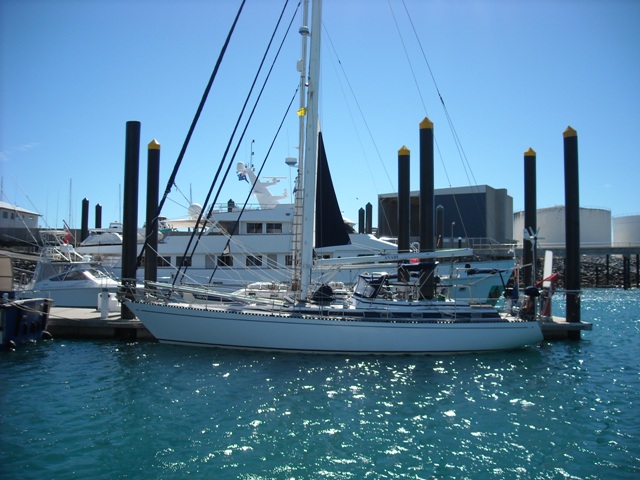
"Anahi" moored at the quarantine quay, Mackay
Marina
No way to hide something, they literally search the boat!
Once cleared, we explore the place which is very nice, but very isolated, and the temperature is low, we are
freezing!!
The small town of Darwin, few kilometers away,
reminds us the american midwest.
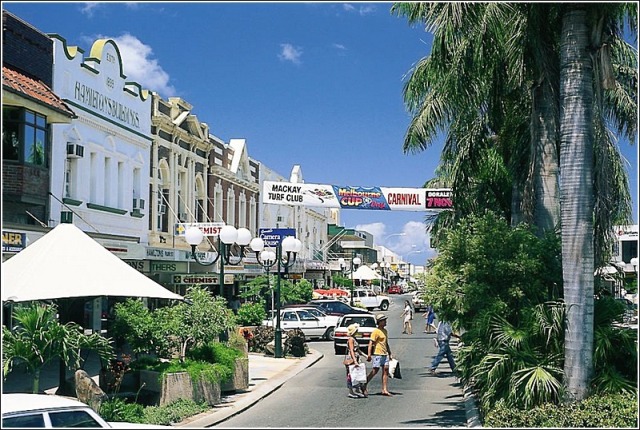
This is a relatively wealthy area, thanks to the
large sugar-cane plantations and to the coal industry that boasts the world's
largest coal terminal, and prices are accordingly high.
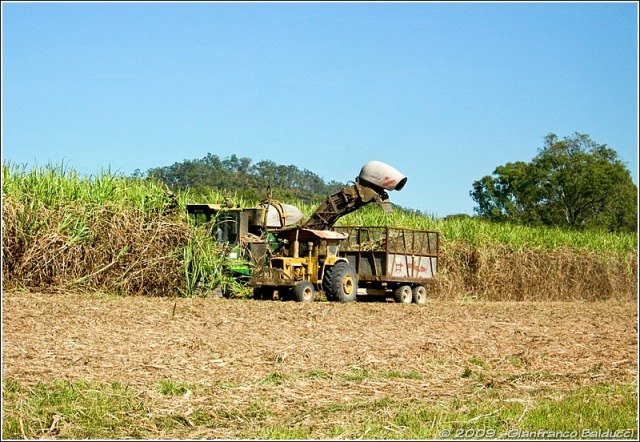
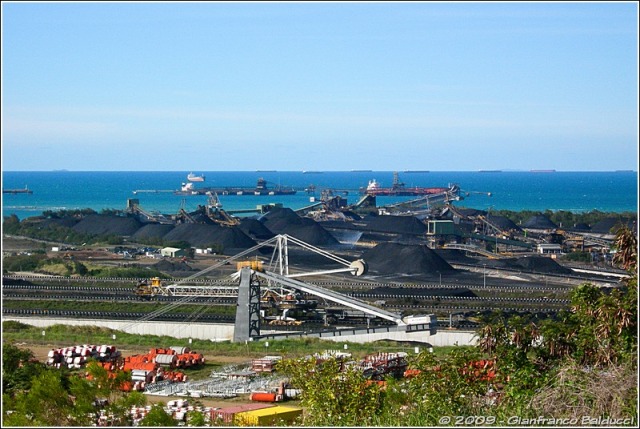
Sugar-cane
harvesting....
...and the world's largest coal terminal (note the ships in the background...)
23/08/2008
KANGAROOS AND PLATYPI.... (or whatever the plural of "platypus" is...)
Not all Australian animals are either venomous or aggressive, but seeing one is
a tough job!
Once past the thorough immigration and quarantine procedures and well settled in
the huge Mackay Marina, it was time to start exploring the neighbourhood.
First visit, the Cape Hillsborough National Park: here Kangaroos use to descend
onto the beach, but they were informed of our arrival and went elsewhere!
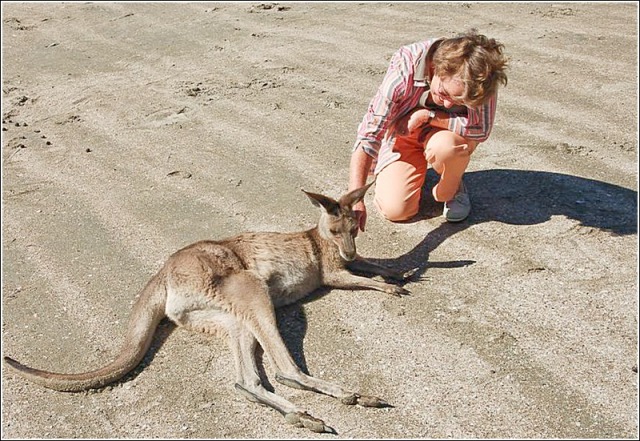
Annette, the Blue Water Rally secretary, was
luckier on a previous visit and found a wallaby on the beach
On our way back, we saw one merrily jumping away: we are told it's a Wallaby and
not a Kangaroo, although the difference is not evident to us and then who cares,
we saw ONE!
Next visit, the Eungella National Park: one and a half hour by car to arrive
there, and then we place ourselves near a little river where Platypii are known
to live. Half an hour waiting, and a Platypus makes a brief appearance: we
expected something as big as a beaver, while it's much smaller, but at least we
saw ONE!
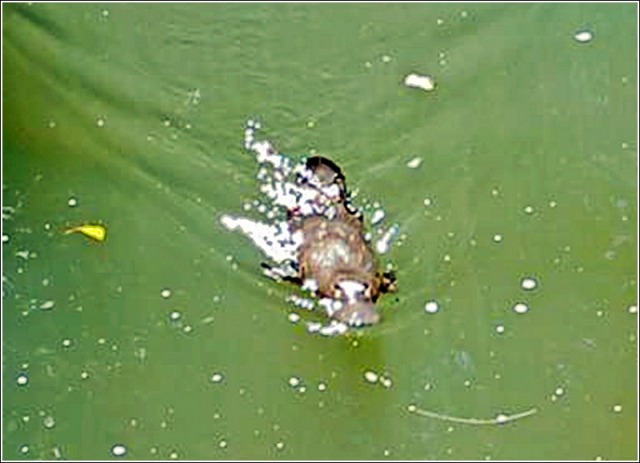
The heavily enlarged picture of a small
platypus
On our way back, we spot a Cookaburra sitting on a tree, so check this one out!
Not a lot, for 2 days and 300 dollars worth of trips....
Yesterday at last we left Mackay with Shaula3, bound for Cairns by way of the
supposedly very Beautifull Whitsunday islands, where we plan to spend a few days
jumping from one island to the other.
Oddly, no wind: not a good sign, it means the weather is unsettled, but at least
in a flat-calm sea we have crossed paths with a whale!! It was about time, ALL
in the Rally have spotted whales in large numbers, while we had only spotted in
the distance the tail of a Sperm-whale when we were approaching Galapagos and
that was all!!
Then this afternoon, two HUGE sea-turtles were mating unashamedly less than 100
metres away, oblivious to all moored boats!
We still miss:
- Real Kangaroos
- Crocodiles, both the river and the sea variety (and we can easily do without!)
- Assorted Snakes (same concept applies)
- Killer Jellyfishes (same...)
- Man-eating sharks (could do without, thanks!...)
27/08/2008
WHITSUNDAYS
Along the Australian eastern coastline, winds blow most of the time between East
and South-East with brief exceptions usually lasting only 2 or 3 days; only in
Spring, between October and December, the wind may blow from the North for
sustained periods of time.
The Australian yachtsman who decides to venture north from Sidney or Brisbane
may therefore have to wait until Springtime to sail the boat back home...
No wonder therefore that the area around the Whitsunday islands is so popular,
with so many islands few miles one from the other and many Beautifull and
sheltered harbours which can be easily reached from one of the several marinas
along the coast to spend a whole vacation hopping from one island to the next.
Many charter boats, we even met an Italian family who came over here for a
vacation!
Most islands are part of a National Park, so there are almost no infrastructures
on land, apart from a few walking tracks.
Covered by a lush vegetation and with relatively few beaches that almost
disappear at high tide, the islands are rich of fauna: whales pass nearby with
their newly-born, and we saw many large sea-turtles swimming without fear among
the anchored yachts. In some harbours there should also be Dugongs, but we have
not been so lucky to spot them.
Birds aplenty, including some huge and noisy white parrots that in the morning
went from one yacht to the other.
We did not see crocodiles, which do not come often so much offshore, although
some years ago one was spotted in one of the northern islands) and we did not
dare bathing in a rather murky water (although we have been told that some areas
are very good for snorkelling).
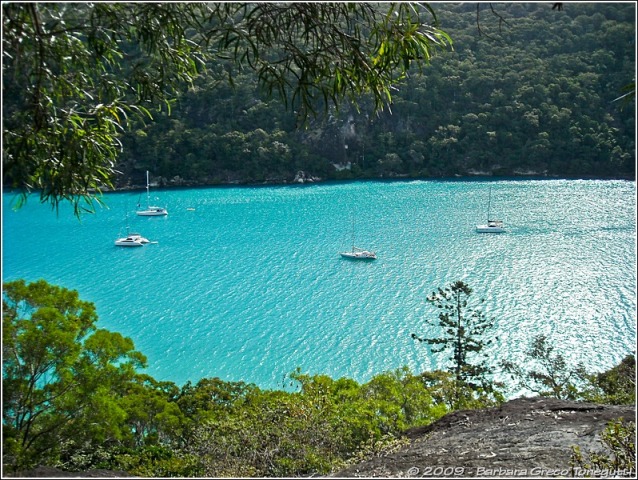
Shaula at anchor in Hook island's long fjord; a
popular spot also among Australians!
In Hook island we climbed up to a small cave which used to be an aboriginal
settlement: a mound of empty shells on the outside, and some drawings, whose
meaning is quite obscure, on the inside of the cave (to me, they seem like
fishing nets: who knows, maybe they were representing each fishing season spent
on the island? As good a theory as any!...).
29/08/2008
THAR BLOOOWS!...
Eh yes, we were very envious of most other crews that already sighted a lot of
whales, while we never saw one, even when we were in the same area of the lucky
ones!
Then, few days ago while we were sailing in the narrow passages around the
Whitsunday islands, we sighted one which surfaced just beside us, with the
regulatory blow and all, and next day we saw two more which were swimming
side-by-side.
Two days ago, we decided to stop for few hours at Orpheus island, while waiting
for the rising tide to allow us entry into the Hinchinbrook channel, and there
we really saw whales!!
One sighting was very peculiar: the whale was keeping her big tail vertical out
of the water, without moving, then after a while we saw a calf (4 or 5 meters of
"baby"!...) swimming around the tail which kept staying still.
We tiptoed away, to avoid any possible reaction from the mother in defence of
the baby, while wondering what could be the reason for that strange posture: was
she feeding the baby? Was she delivering it? We will have to document ourselves.
Later we went into the Hinchinbrook channel, where we decided to spend the
night: Beautifull and highly scenic, but we saw very little living forms, just
few birds (and no crocs, so far!!).
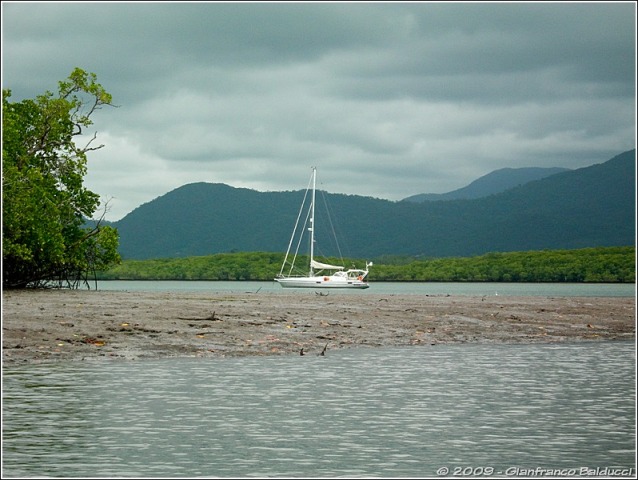
Shaula anchored in the Hinchinbrook channel,
running between the island of the same name and the mainland
...and what about CAIRNS?
Oddly, during the voyage we did
not spend a word about Cairns. We reached the cosy and
welcoming Yorkney's Knob Marina, few miles north of Cairns, when most Rally
yachts had already left, so we could spend only few days there.
A larger town compared to Mackay, Cairns is the hub of tourism towards the Great
Barrier Reef, and we found elegant shops, luxury items, indigenous handywork
sold at high prices, but also (at last!) a well-stocked shipchandler.
We did not have much time
available for tourism, but at least we allowed ourselves a trip on the Kuranda
Historical train, leading to the former mining town of Kuranda, now transformed
in a tourist-trap.
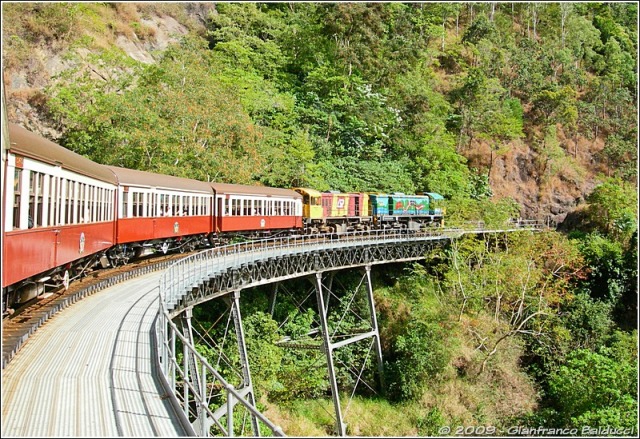
The Kuranda hystorical train
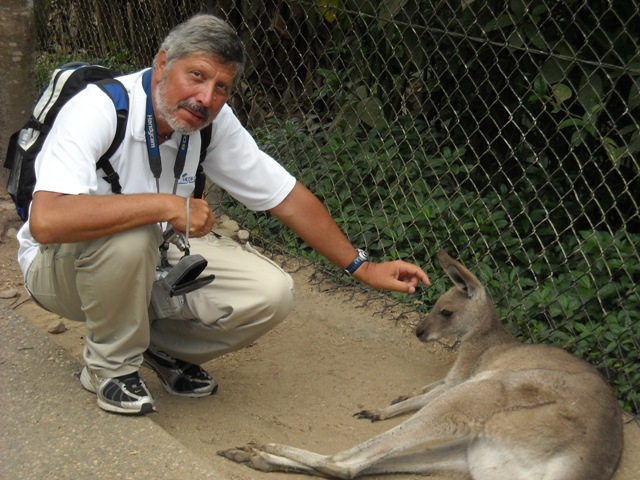
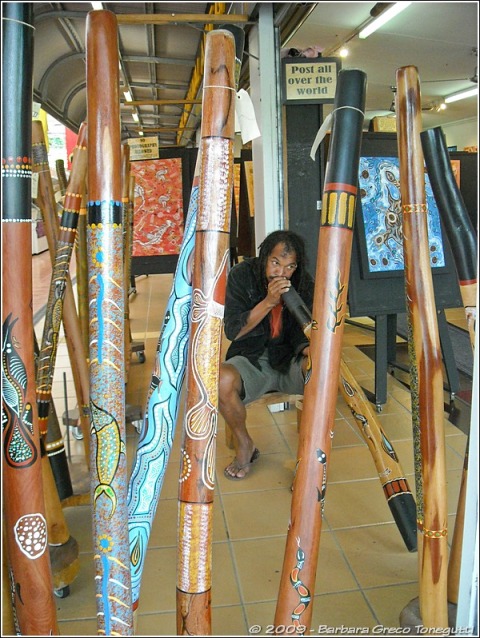
(left) a Wallaby in Kuranda's little zoo
(right) an artist demonstrating how to play the Didgeridoo
We rented a car for victualling,
and we took advantage of it to ride north towards Townsville, and from there on
a boat along the Daintree river to spot crocodiles in the wild and then further
north to Cape Tribulation, so named by Cook after a long fight to double this
headland against strong adverse currents!
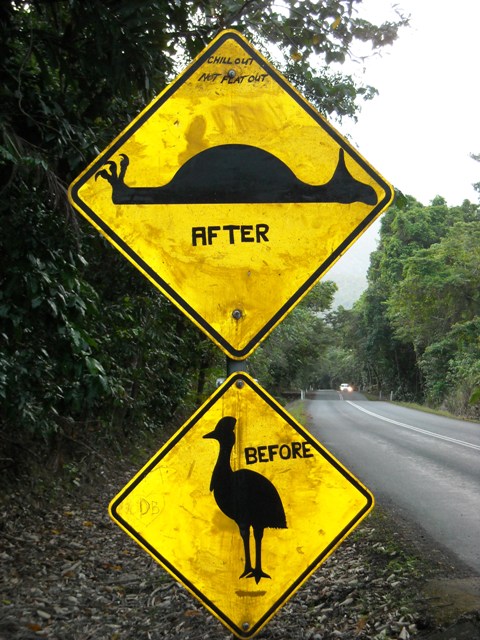
This road sign on the way to Cape Tribulation
(an unknown artist's modification of a standard road-bump sign) has become
famous worldwide!
09/09/2008
JAMES COOK
One of the many possible ways to read this voyage is through the great
characters who are tied to the various places: Christopher Columbus in Canary
islands and through the Atlantic, Nelson in Antigua, Drake in Portobello and
Panama, Darwin at the Galapagos islands, Bougainville and Cook along the Pacific
Islands.
Along the route we are currently sailing, going north inside the Great Barrier
Reef, it's Cook again that we follow along the same course he sailed back in
1770.
Right, 1770: few years before the American and French revolutions and the
Napoleonic wars, Australia was still largely unexplored, even though probably
well known to the sailors from nearby asian Countries.
When he left in 1768 aboard the "Endeavour", Cook got secret instructions from
the Admiralty, besides his official mission to take the opportunity to claim
ownership to as much land as possible in the new Continent, compatibly with the
natives' attitude.
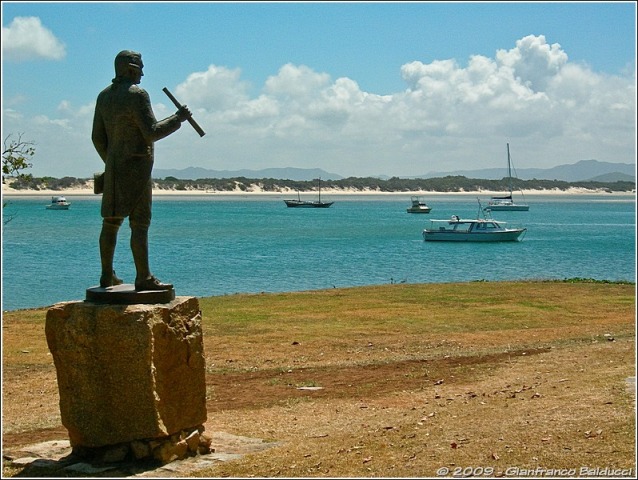
The monument to James Cook near the estuary of
the Endeavour river, Cooktown.
Yesterday morning we anchored in front of Cooktown, a very small town located
where Cook spent nearly two months repairing the Endeavour after having hit what
is nowadays known as "Endeavour reef". In 1970 the anchors and cannon dropped by
Cook on the reef during his efforts to free the ship have been found and
recovered, and some of them are now on show in Cooktown's small Museum.
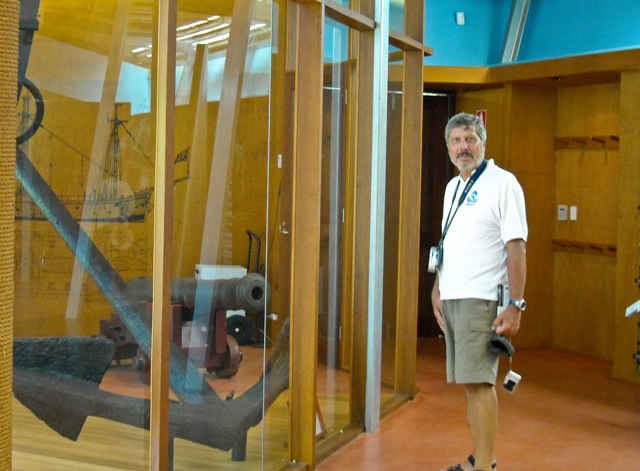
An anchor and a cannon from the Endeavour,
found were Cook jettysoned them to refloat his stranded ship
In fact the town was born about one century later, in the wake of the Australian
Gold Rush, and since then it has shrunk significantly although it still
preserves the looks of a frontier town: today, it is the jump-off point for 4WD
expeditions to the north, through Aboriginal Land up to Cape York.
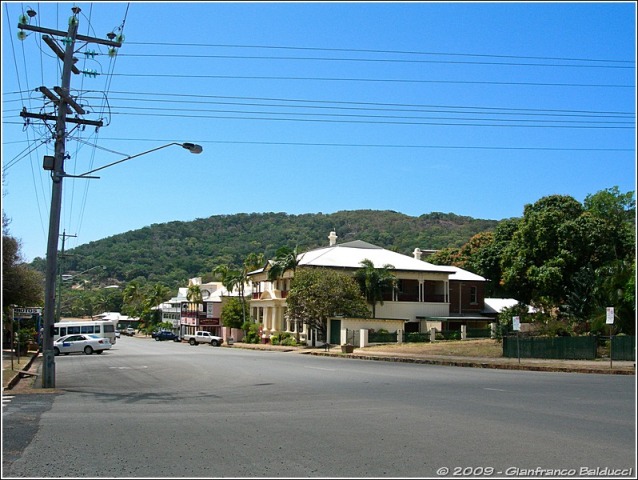
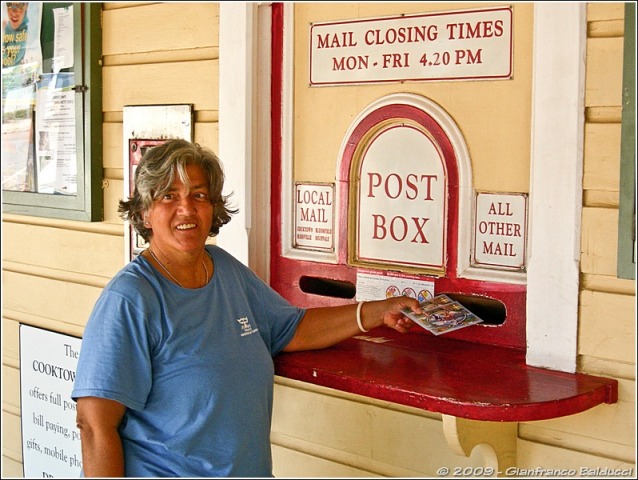
(Left) Cooktown's main road
the old-fashioned post-office (right)
Today we are in Lizard Island, and here again you find Cook, who climbed the
island's hill to have a view of the surrounding reef, looking for openings. In
fact the island is better known for a tragedy dating to 1881, when the wife of
an early settler escaped from an attack by aborigines together with her little
baby and a chinese servant, quite literally aboard a bathtub! Unfortunately they
were swept on another island were they all died of thirst; their bodies were
later buried in Cooktown, where a monument still stands to tell their story.
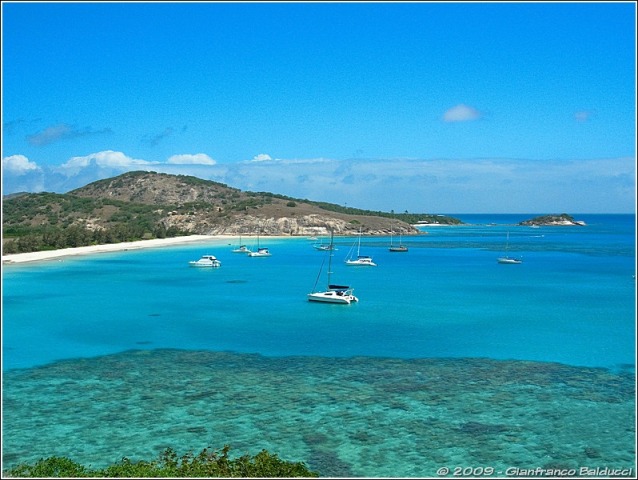
Lizard island's spectacular anchorage
Maybe in Australia you cannot swim a lot, but you certainly learn a lot!!
13/09/2008
CROCODILE...
After Cooktown and Lizard Island, another peculiar experience: the other day we
anchored at Morris Island, a typical example of the islands in this part of the
Great Barrier: a wide coral reef just under the surface, and a tiny islet just
protruding out of the water, covered with bush and the occasional palm tree.
We anchored in a "cove" formed by the reef, not by the island, and at high tide
when the reef is submerged it looks like we are anchored in the middle of the
sea!
We went ashore in the dinghy, just to walk around the island, looking carefully
around and avoiding entering the shrubs because years ago a crocodile was
reported living on the island.
We see and hear nothing suspicious, so after a while we go inland for maybe 10
meters, reaching a tomb under the shadow of the island's only palm tree:
probably a fisherman of the early 20th century, when fishing ships working in the area
had no other option, in case of the death of a crewmember, that burying him on
one of the many islets. Not a rare occurrence, and these tombs exist in several
places.
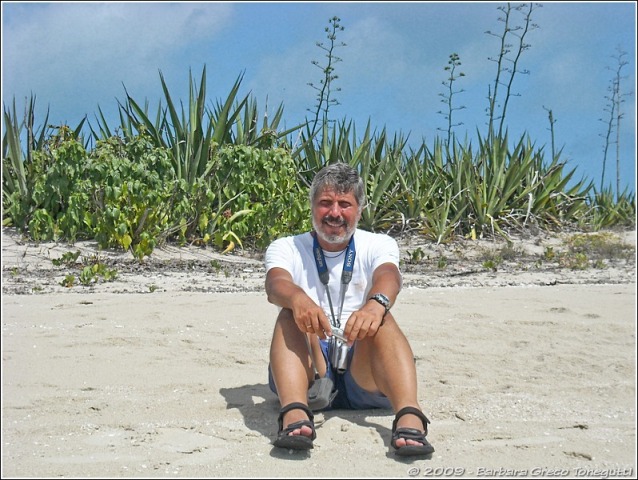
Merrily seated on the beach at Morris island,
few meters from the bushes hiding a crocodile...
We returned to the boat without having seen any trace of the croc and thinking
that maybe he left the island years ago.
Next morning we set sail early for a long leg north, while "Stargazer" remains
at anchor for a few more hours.
You should have seen our faces when, during the radio chat of the afternoon, the
crew of "Stargazer" told us that they saw the crocodile! A beast of about 15
feet which first went sunbathing on the beach, few meters from the palm tree
where we went yesterday, and then went in the water in search of food!
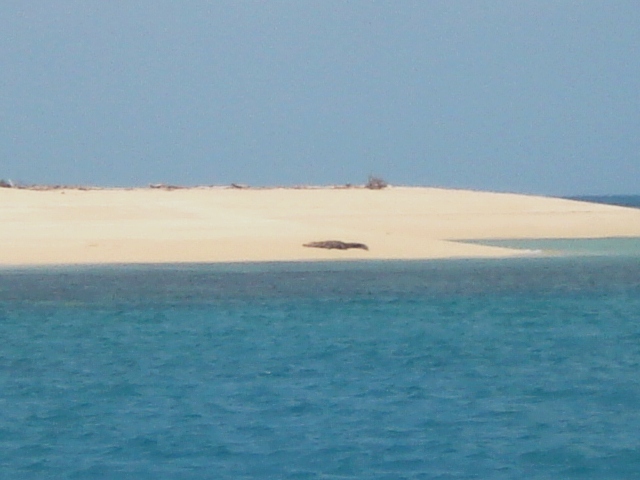
Same beach were we were the day before, a big
croc is basking in the sun....
Fear in retrospective: probably due to the noise of 4 boats at anchor, with
dinghies motoring back and forwards and people walking around the island, the
croc opted to stay hidden, but we must have passed few meters from the beast
without seeing or hearing it...
15/09/2008
CROCODILE, PART-2
We passed Cape York, the northernmost tip of Queensland, and we officially left
the Coral Sea: we are now in the Arafura Sea (never heard before? we neither!)
and we are asking ourselves whether this is or not a part of the Indian Ocean (probably
it is?).
The passage around the Cape has been very fast, with a strong favourable current
and a rather fresh wind which often blew in excess of 30 knots, so that at one
point we were doing 10,5 knots! Unfortunately wind and current did not abate
even in the Red Island anchorage where we went together with several other Rally
yachts.
We were just settled there when we noticed Michael of "Big Blue" going back and
forwards in a dinghy belonging to another boat: after a while we understood he
was laying a rope between the stern of a big motor-boat and a sort of schooner
which was laying at a strange angle. No surprise, it was grounded!
Pull and pull, the schooner is freed, only to get stuck again just 20 meters to
our back! We join the help party, and help laying two anchors up-tide to help
preventing the boat to get stuck further in with the raising tide, and then
there was only to wait for high-water.
We chat, we drink, and inevitably the conversation falls on the location we are
in, and on the inevitable question about crocodiles: are they really around? And
the inevitable answer comes: yes, they are, just last week one could be seen for
several days sunbathing on the beach, down there!
Ok, understood, no swimming once again...
19/09/2008
CROCS AND CUSTOMS...
Along the northern shores of Australia smuggling (both of people and of various
other stuff, mostly drugs) is a real problem so the Australians are taking it
seriously.
Two days ago, a cry from below-decks: "GIAAAN, there's an echo on the radar that
is coming at us very faaaast!"
I look forwards, nothing, then I bend to look under the genoa and there was an
AIRPLANE coming towards us low over the sea!!
They do two or three passes and finally call us on the radio with the usual
questions: boat name, port of registration, last and next port of call, and then
they leave with a promise: "we'll see you every day".
Next day, another cry: "GIAAAN, there's a ship coming at us, what do I do,
change course by 2 degreeees?"
The ship turns out to be a large Australian gunboat that comes thirty meters
from us, gives us a long look without a word over the radio and then kicks away.
Yesterday, a similar vessel passes by a couple of miles away, calls with the
usual questions, says goodbye and goes away in the direction of "Jupiter" which
is few miles away and DOES NOT ANSWER to their calls!! (no surprise, they were
not answering us as well, the two frenchmen often keep their radio off...). We
were already figuring Pascal and Patrice in chains while Jupiter was being sunk
by gunshot, but instead the patrol boat kept going and went to bother some other
boat a little bit farther away.
What has the crocodile to do with all this?? During the evening radio chat,
Zipadedoda ("Zippy") reported having just seen a crocodile, happily swimming
along 40 MILES from shore!!!
Who knows, maybe the Australians will ask to see his passport???
05/10/2008
THE CROC'S LAST WORD...
After having sailed along nearly one third of Australian coast without spotting
a single dangerous beast, it is unavoidable to start thinking that there is a
lot of exaggeration (although we do not forget the croc spotted by Stargazer in
Morris island the day after we walked on the same beach...).
Then, just on the day before our departure, we spot the local newspapers'
headlines: "tourist killed by a croc!!".
Apparently the poor fellow had ventured on the river's shore near Cooktown (where
we have been not more than a couple of weeks ago) and disappeared: only
remainders, a pair of sandals found several hundred meters one from the other,
the camera and a watch on the shore.
It is suspected that he may have been attacked by a large croc which is know to
frequent the area!...
DARWIN
Our last stop in Australia, and
first thing we have to spend a night at anchor in the harbour to be "sanitized"
against a pestiferous shell that clogs the engines' water pipes, causing great
damages.
Our stop will last some days
because we will have to finalize the formalities to get a cruising permit for
Indonesia.
Unfortunately two events give a
serious blow to our reserve funds: first, the outboard motor that took a plunge
during our capsize in the Caribbean and that we later repaired has broken again
and this time we had to scrap it for good and buy a new one!
Then, we are informed that Indonesia has put in place new rules requiring
passing yachts to pay a huge deposit, unless our visit is "guaranteed" by a
local sponsor, who asks a fee of 1000 US$ per boat!
The only alternative is to go
straight to Bali, so like most other crews we byte the bullet and pay.
With our funds seriously
impacted, we had to cut short on tourism, and limit ourselves to a one-day trip
to the Litchfield National Park; the main attraction are the huge "magnetic
termite-mounds", so called because they are aligned with the Earth's magnetic
field.
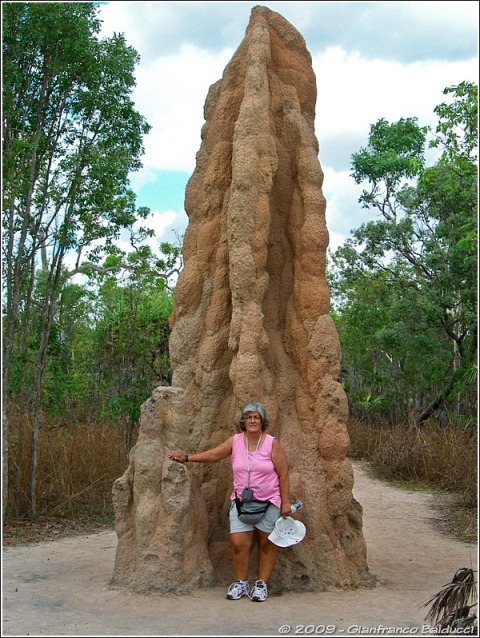 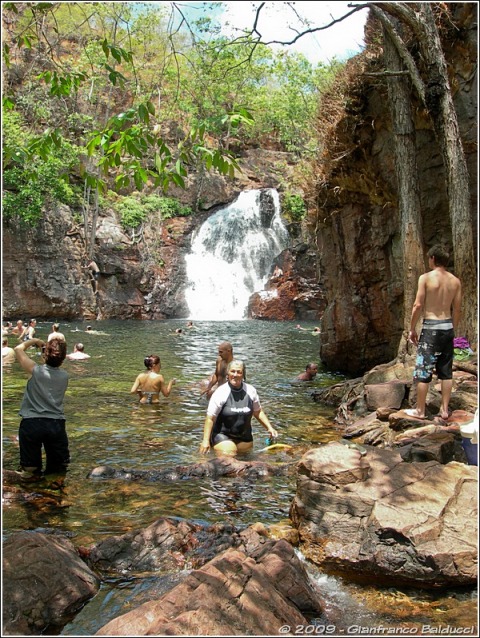
11/10/2008
AUSTRALIAN SUMMARY?...
So, how was Australia??
I do not believe I can really draw any conclusion: the country is huge,
distances between highlights are considerable, and we visited only the coastline
of the remotest and less-inhabited part of the country, and did not visit any of
the major towns.
Mackay, the new frontier: coal mines and sugarcane, high wages and astronomical
prices, nobody wants to be a bus-driver or a plumber when mines pay much better!
Cairns, the tourist hub: tourist shops, trips and tours, diving expeditions to
the Barrier reef, the historical train to Kuranda (originally laid down to serve the gold mines in the interior), our
first encounter with aboriginal handycraft (hand-painted boomerangs and
didgeridoos, among all) but very few aboriginal people in sight (and the few,
almost always drunk: a serious problem!)
Cooktown, the old-frontier outpost now departure point for the 4WD tracks
leading to Cape York, with its little museum hosting some remains from the "Endeavour"
(guns and anchors dropped at sea to free the ship from the coral), the monuments
to Cook and to the Watson family (victims of a confrontation with the
aboriginals).
Seisia, small village in the aboriginal territory at the other end of the Cape
York track, where aboriginals drive SUV's...
Darwin, the only major town in the north, where it plays the role of hub for
tourist tours towards the great National Parks within the aboriginal lands, less
luxurious than Cairns and terribly HOT!!! (30 degrees at night in the first days
of spring???).
And what about the aboriginals? The official attitude of Australia towards those
they now call "the traditional owners" seems in good faith, nevertheless they seem
to prefer to keep on their own, with the few exceptions of those who have
integrated. Every now and then they may come to town in small family groups, but
you do not see many and visiting their territories is not allowed without their
permission.
We missed the middle of the Country, Alice Springs ed Ayers' Rock: only the crew
of "Misstix" has ventured there with a week-long, 6000 Km ride by car (!!!!...)
hitting kangaroos along the way and coming back enchanted.
The only conclusion so far: me must come back!
CONTINUE
READING...
|